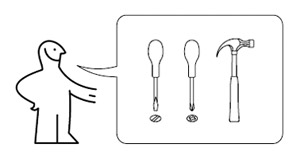A Lesson in Communication from IKEA

Ever been to IKEA? It’s a literal wonderland of home goods… and Swedish meatballs. In fact, just a few months ago, I was there spending way too much money on cutting boards, various pans of debatable quality and other unnecessary but useful household items. My girlfriend, Kate, and I picked up some pretty epic funnels for a buck—you can’t tell me that’s not awesome. Or maybe you can? But we’re moving on. IKEA is a truly magical shopping experience, giving customers the option to choose their own paths as they either weave through the preset room-themed routes, or carve their way through various departmental shortcuts. And despite the control customers have, they are still strategically guided through sections of the store while being shown a multitude of highlighted products. Somehow, my shopping experiences gave me the epiphany that IKEA’s customer herding techniques could lead to some great lessons in communications. Please follow the aisle to paragraph two.
Call me naive, but I see two fundamental ways of delivering a message. First, the bare-bones point A to point B approach, where the message receiver is only offered what’s necessary. There are few details given, as there is only one necessary point to make. Why confuse the masses with more information than what’s required? But is this ever enough, or will it leave a lousy taste in the mouths of your message’s recipients? Maybe it's too simple.
The other possible approach is something I define as a more psychological and multifaceted approach, laying breadcrumbs for both current, past and future messages as reference points. Sure, there are plenty variations of the two, and I’m speaking primarily from an observational standpoint, but please allow me to remain atop my soapbox. (I’ve spent an embarrassing amount of time prettying it up, and I’d hate for it to go to waste.) Generally speaking, I place an IKEA shopping experience in the second option (who didn’t see that coming?). Oh, and by the way, it works.
I don’t think it’s possible to walk into IKEA for one thing, and leave with just one thing. (Though, I suppose its possible to go in for one thing and leave with nothing, but I digress.) The store designers at IKEA are well versed in tempting you with what you want, while bypassing the fact you may not need it. Yeah, I am looking to buy a book shelf. Whoa, are those epic little fabric drawers? And a cute little bamboo plant? And some stylish little lamp? Sign me up; I had no idea these things existed before I went looking for this shelving system!… Something like that. 
While these extra factoids might be distracting, it’s up to all of us wordsmiths to figure out what details are important as an additive to the primary message versus the details that are trivial and disrupting. IKEA is generally setup in a way where you may find repetitive yet complementary items sprinkled throughout the departments—simply because they work there—and, of course, for emphasis. You won’t see a mattress sitting in a bathroom, for example, or a frying pan in the bedroom. (Please, let’s not think of a reason why it’d be there.) When in doubt, less is more; don’t overwhelm the audience. Perhaps just whelming them will do? Obviously, some assembly is required.
Who knew IKEA could serve as such a valuable lesson for all of us communications types? Be sure to always ask yourself: does chair A belong in room B? When in doubt, keep it simple, as less is more. And just remember, don’t mix microwaves and sofas when you string together your optimized bathroom—it probably won’t end up well, and people won’t take you too seriously (that is, unless you’re in the 1%). ![]()
